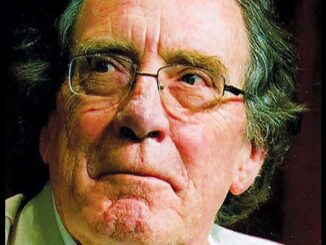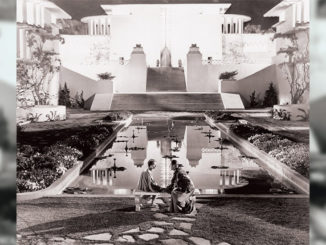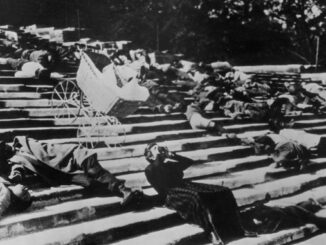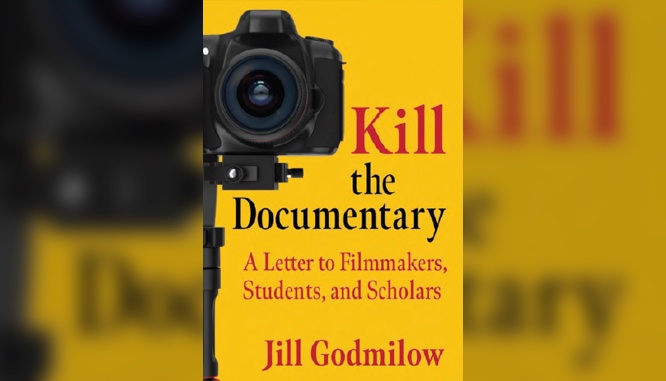
By Betsy A. McLane
Jill Godmilow believes that Harun F arocki (1944-2014) was history’s greatest documentary filmmaker. If one is familiar with Farocki’s work — he made over 90 films, mostly German language shorts — her view is a starting point for interesting debate. However, discussing Farocki is difficult for most people, since his work is not well-known by the public, is hard to access, and when seen can be confusing with its combination of experiment, document, and art. None of his films are commercial in any sense of the word, and some are seen only in museums and art galleries. Godmilow is herself a filmmaker and a writer working apart from commercial interests. She shares with Farocki a deeply political and extremely critical leftist perspective. Her most widely seen film is “Antonia: A Portrait of a Woman” (1974), directed with singer-songwriter Judy Collins. This traditional portrait biography of Antonia Brico, the first female conductor of major orchestras in Europe and the US, was nominated for an Oscar for Best Documentary Feature. Most of Godmilow’s other films are decidedly non-traditional, and were made while she had the professional support of decades as a professor, now emerita, at The University of Notre Dame.
At Notre Dame, Godmilow taught classes in filmmaking and critical studies, and “Kill the Documentary” reads like a distillation of approaches and theories she developed there. The book’s subtitle, “A Letter to Filmmakers, Students, and Scholars,” is apt, since the writing style is informal, almost to the point of being haphazard. That is okay in a letter, and perhaps in a manifesto, the latter a term that perhaps better describes “Kill the Documentary,” as Bill Nichols writes in his introduction. Reading it, one can hear Godmilow’s voice in the seminar room or on a student film shoot, filled with the enthusiasm necessary for good teaching.
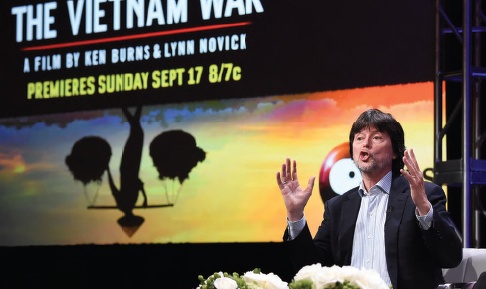
Godmilow strives to disavow all the many forms of documentary as we know it. She champions the “post-realist documentary” as far superior to any other type and offers it as a koan, a paradoxical Zen riddle. Each chapter holds nuggets of insight, but overall the book fails to make a case for post-realism as the way forward for documentary. There are dozens of subheads within each chapter; examples include “Reject the Westerncentric Games Anthropologists Play,” “Reject the Cliches of Journalism,” “Dodge the Privileged Gaze,” and “Exessify It-I Mean Blow it up Big and let us Ponder It.” These four ill-defined mandates are crammed into less than four pages, leaving important questions unanswered. In 2022, are all anthropologists Western-centric, and who in the age of TikTok holds the “privileged gaze”?
Godmilow ‘s overall analysis has two major flaws: one about the documentary past, and one about the documentary audience.
The Past: Her term “post-realist” may be unique when applied to documentary, but realism has always been only one of many authentic nonfiction forms. The following are a few examples. Dating to the Soviet revolutionaries Dziga Vertov and Victor Turin in the 1920s, through to the city symphonies of Europeans Hans Richter and Rene Clair, to the National Film Board of Canada’s Arthur Lipsett and Norman McLaren, to current makers like Jay Rosenblatt and Péter Forgács, individuals and groups have worked to deconstruct documentary form and meaning. Rejecting the “Cliches of Journalism” was the driving force behind the beginning of cinema verité in Canada and in America, by Robert Drew and Drew Associates Leacock, Pennebaker, Maysles. That verité techniques are now tritely and endlessly bastardized does not make these pioneers’ work any less remarkable or valuable. Even Robert Flaherty, excoriated by Godmilow (and others) did not claim to present “the real.” He was interested in creating a paean to a vanishing way of life and did not dispute the facts that scenes were created for the camera and that individuals were cast to fulfill his vision. “Kill the Documentary” even includes a reproduction of an early “Nanook of the North” poster advertising the film as “A Story of Life and Love in the Actual Arctic.” The film was made in the “actual (sub)arctic,” and it is presented as a “story,” in other words, a tale. Flaherty was certainly “Western-centric” in his views, as was almost every person making films in the 1920s. (In 1922, the year “Nanook” was released, approximately seven films were made in China, 10 in Japan, 60 in India, and many thousands in the US and Europe). This does not make a Western viewpoint “right” in 2022, neither does it make the films “wrong.” Another of Godmilow’s topics, “Games Anthropologists Play” has been exploded in many documentaries. Sol Worth’s and John Adair’s late 1960s “Through Navajo Eyes” project and Australian Dennis O’Rourke’s ten remarkable films made between 1976-2004, all question the roles of the maker and the audience in portraying and consuming indigenous cultures.
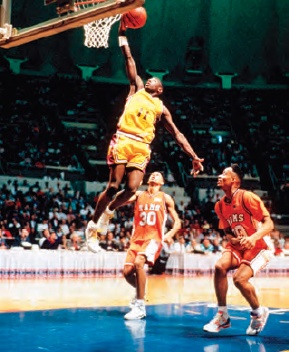
The Audience: Relatively few people have seen Farocki’s films. Fewer have seen Godmilow’s. That and the fact that they do not make much money does not render them less or more valuable. Millions have watched “Hoop Dreams” and Ken Burns’ work. The fact that they have huge audiences makes them neither more nor less valuable. Godmilow singles out Steve James’ “Hoop Dreams” and Burns’ and Lynn Novick’s “Vietnam” series for special contempt. She categorizes “Vietnam” as “documentary war porn.” She sees these as works that allow audiences to falsely feel that they understand the problems of inner-city black kids or the American War in Vietnam while reinforcing complacency, rather than prompting political and social action. Ken Burns makes historical films, and in fact considers himself first an historian. Steve James makes films that focus on personal stories about how individuals and families make their way in the world. One can criticize both these filmmakers, but to excoriate their work as damaging ignores the vital ways that they offer information and insight to tens of millions of people. Most people who watch Burns’ and James’ films will never see Farocki’s, and if they did, and if they could relate to the form and content, they would likely still not be moved to act.
‘Documentary war porn’ is how Godmilow dismisses Ken Burns’ ‘Vietnam.’
Fifty years ago, when Godmilow began making films, only a handful of English-language books devoted to documentary film existed. John Grierson’s “Grierson on Documentary” (1946), “Documentary Film: The Use of the Film Medium to Interpret Creatively and in Social Terms the Life of the People as it Exists in Reality” by Paul Rotha, Sinclair Lewis, and Richard Griffith (1964), “The Documentary Tradition,” a selection of essays edited by Lewis Jacobs (1971), and “Documentary Diary: An Informal History of the British Documentary Film,” 1928-1939 by Paul Rotha (1973) were, along with the writings of Frances and Robert Flaherty, the main ones. The long-time authority, Erik Barnouw’s “Documentary: A History of the Nonfiction Film,” was first published in 1974, the same year that “Antonia: A Portrait of a Woman” was released. Godmilow’s approach did not stem from any of these traditional sources, nor from the hundreds upon hundreds of books about documentary published since then. [Disclaimer: my own book “A New History of Documentary Film” will be published in its Third Edition later this year by Bloomsbury.] Her inspiration comes from poetry and far left-of-center politics, combined in an admirable desire to create alternative nonfiction, inspire others to do the same, and have a great deal of fun along the way. This is a splendid ambition, but Godmilow’s approach lacks understanding of documentary history and does nothing to secure audiences for postrealist documentary films, nor livelihoods for their makers. “Kill the Documentary” is published as part of the “Investigating Visible Evidence: New Challenges in Documentary” series. Visible Evidence is an organization of “scholars and practitioners engaged in research and debates on historical and contemporary documentary practice and nonfiction media culture.” To be published under its auspices means that the key figures in current scholarly work on documentary find “Kill the Documentary” worthy, a status underlined by a forward from eminent scholar Bill Nichols. It is to the series editors’ credit that they chose the book, which although not a typical academic volume, is thorough in its footnotes, filmography, and bibliography, and has a list of “144 feature films you should see before you croak.” It is a good list.
There are other good things in “Kill the Documentary.” Advice such as “Leave your parents out of this” is useful, especially for film students. While almost 80, Godmilow’s liveliness and untrammeled spirit recasts 1960s and 1970s activism for new documentarians, who will hopefully be inspired. Her impassioned prose and obvious sense of humor are entertaining. Proclaiming that “the traditional documentary is the most enduring vestige of cultural imperialism” is intended to raise hackles. Those who agree with the statement might well focus their attention not only on film and television, but on the extraordinary cultural power of video games and social media to document the world. This book deserves attention; it is heartening to hear directly from a filmmaker who is unafraid to stake out a position. “Kill the Documentary” also introduces readers to an array of fascinating documentaries and may even get people to seek out the films of Harun Farocki.
“Kill the Documentary: A Letter to Filmmakers, Students, and Scholars”
by Jill Godmilow
Columbia University Press, 2022 189 pages



